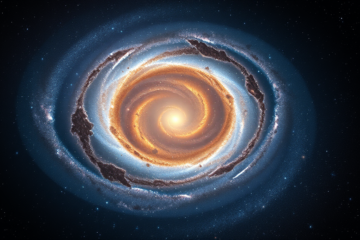Rare Alignment of Planets in the Brazilian Sky
Planetary Alignment is a fascinating celestial phenomenon that intrigues astronomers and sky enthusiasts.
On September 8, 2040, the planets Mercury, Venus, Mars, Jupiter and Saturn will form an impressive alignment, presenting a visual spectacle on Brazilian nights.
In this article, we will explore the nature of this rare event, its ideal observing conditions, and the historical significance of planetary alignments, as well as discuss when we will next have a similar opportunity.
Prepare yourself for a journey through space and time, where the beauty of the cosmos unfolds before our eyes.
Planetary Alignment of September 8, 2040
On September 8, 2040, five planets — Mercury, Venus, Mars, Jupiter, and Saturn — will be perfectly aligned in a straight line in the Brazilian sky, visible at an angular distance of just 9.3 degrees.
This rare phenomenon occurs when all the planets are positioned in the same line of sight from Earth, creating a unique visual spectacle.
For astronomy lovers and the curious, this will be an unmissable moment to observe the beauty of the universe.
Ideal Conditions for Observation
For a privileged view of the planetary alignment on September 8, 2040 in Brazil, it is crucial to find a location with obstacle-free western horizon such as buildings, trees or mountains.
These elements can obstruct viewing just after sunset, when conditions are ideal for observing the spectacle.
The presence of a night clear and cloudless is equally important, as clear skies allow the planets' brightness to stand out dazzlingly.
Furthermore, you should choose an environment away from light pollution in cities, where artificial lights do not interfere with observing the night sky.
This rare phenomenon is a unique moment for astronomy lovers to experience a celestial spectacle of rare beauty.
Therefore, enjoying rural areas or beaches can be an excellent choice to escape the excessive brightness of urban lights.
Thus, when contemplating the horizon, the experience will become unforgettable, providing a unique connection with the immensity of the cosmos, highlighting the majesty of the universe through the clear visualization of the aligned planets.
For more information on celestial events, check out Learn more about alignment and how to observe it.
Identifying Planets During Alignment
Venus will stand out significantly in the Brazilian sky during the rare alignment of 2040, lighting up the sky in an impressive way.
Its strong brightness will make it easy to identify, making it a quick reference in the sky.
Already Mercury will present a greater challenge, as it will appear close to the horizon, with less intense brightness.
Take advantage of the twilight to try to capture it with an unobstructed view.
Mars will show its characteristic reddish coloration, a tone that will stand out among the surrounding stars.
Jupiter will display a constant light, similar to a large star, while Saturn will provide its charm with a welcoming yellowish coloration, visible in good atmospheric conditions.
The experience will be a real celestial spectacle, emphasizing the unique beauty of our solar system.
History and Projections of Similar Alignments
In February 2025, a planetary alignment of five planets shone in the sky, creating a wave of excitement among observers of the universe and setting a benchmark for future astronomical analyses.
This event was a rare spectacle that united the planets Mercury, Venus, Mars, Jupiter and Saturn in a single visual line, providing a heavenly show which fascinated many.
The next similar alignment is projected for the late 25th century, offering a valuable future opportunity for astronomy enthusiasts.
This 25th century celestial configuration reinforces the extreme rarity of this phenomenon, highlighting the importance of taking advantage of any opportunity to observe it.
This incredible phenomenon highlights the importance of locating yourself in a space with an unobstructed view of the western horizon.
For those who want to be prepared for the 2040 event, the G1 Globo Science suggests look for places with clear nights and learn to differentiate the brightness and color of the planets.
This spectacular alignment reminds us how skywatching ignites human fascination with the cosmos, as we eagerly await the end of the 25th century for a new viewing of this wondrous cosmic spectacle.
Visual Phenomenon Without Gravitational Impact
On September 8, 2040, a stunning phenomenon will occur when Mercury, Venus, Mars, Jupiter It is Saturn align in the Brazilian sky.
This visual alignment, however, has no noticeable gravitational effect on Earth.
Even with the combined mass of these planets, the force is not enough to influence tides, climate, or any geological activity on our planet.
Experts say the event is without any gravitational influence, offering only a celestial spectacle.
For more scientific information about similar events, you can check out the website of The Globe. It's a unique opportunity to observe the alignment, but no need to worry with any physical impact due to the arrangement of the planets in Earth's line of sight.
The last similar event was in 2025, and the next one will not occur until the end of the 25th century.
In short, the 2040 planetary alignment promises to be a unique visual experience.
It's an unmissable opportunity to observe the sky and reflect on the grandeur of the universe.



0 Comments